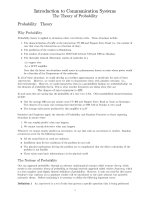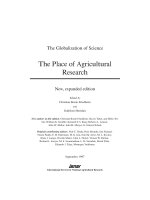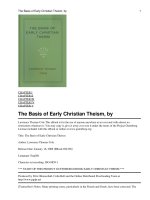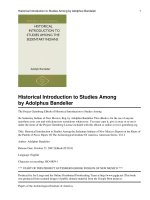introduction to architectural science - the basis of sustainable design
Bạn đang xem bản rút gọn của tài liệu. Xem và tải ngay bản đầy đủ của tài liệu tại đây (5.96 MB, 351 trang )
“fm” — 2003/10/30 — pagei—#1
Introduction to
ARCHITECTURAL SCIENCE
the basis of sustainable design
“fm” — 2003/10/30 — page ii — #2
“fm” — 2003/10/30 — page iii — #3
Introduction to
ARCHITECTURAL SCIENCE
the basis of sustainable design
Steven V. Szokolay
Graphics assistance by
Christopher Brisbin
“fm” — 2003/11/4 — page iv — #4
Architectural Press
An imprint of Elsevier Science
Linacre House, Jordan Hill, Oxford OX2 8DP
200 Wheeler Road, Burlington, MA 01803
First published 2004
Copyright © 2004, Steven Szokolay. All rights reserved
The right of Steven Szokolay to be identified as the author of this work has
been asserted in accordance with the Copyright, Design and Patents Act
1988
All rights reserved. No part of this publication may be reproduced in any
material form (including photocopying or storing in any medium by
electronic means and whether or not transiently or incidentally to some
other use of this publication) without the written permission of the copyright
holder except in accordance with the provisions of the Copyright, Designs
and Patents Act 1988 or under the terms of a licence issued by the
Copyright Licensing Agency Ltd, 90 Tottenham Court Road, London,
England W1T 4LP. Applications for the copyright holder’s written
permission to reproduce any part of this publication should be addressed to
the publishers
British Library Cataloguing in Publication Data
Szokolay, Steven V.
Introduction to architectural science: the basis of sustainable design
1. Architectural design 2. Buildings — Environmental engineering
3. Sustainable architecture I. Title
721
Library of Congress Cataloging in Publication Data
A catalog record for this book is available from the Library of Congress
ISBN 0 7506 58495
For information on all Architectural Press publications visit our website at
www/architecturalpress/com
Typeset by Newgen Imaging Systems (P) Ltd. Chennai, India
Printed and bound in Great Britain
“fm” — 2003/10/30 — pagev—#5
CONTENTS
Introduction vii
List of examples xi
List of figures xiii
List of tables xix
PART 1 Heat: The Thermal Environment 1
PART 2 Light: The Luminous Environment 95
PART 3 Sound: The Sonic Environment 143
PART 4 Resources 191
References 243
Bibliography 245
Data Sheets and Method Sheets 247
Appendix 1 317
Appendix 2 319
Index 321
“fm” — 2003/10/30 — page vi — #6
“fm” — 2003/10/30 — page vii — #7
INTRODUCTION
Four chains of thought led to the idea of this book and to the
definition of its content:
1. It can no longer be disputed that the resources of this earth are
finite, that its capacity to absorb our wastes is limited, that if we
(as a species) want to survive, we can’t continue our ruthless
exploitationof theenvironment. Whereouractions wouldaffect
theenvironment, wemust actin a sustainablemanner. There are
many good books that deal with the need for sustainability (e.g.
Vale and Vale, 1991; Farmer, 1999; Roaf et al., 2001; Smith, 2001;
Beggs, 2002). This book assumes that the reader is in agreement
with these tenets and needs no further persuasion.
2. Architecture is the art and science of building. There exists
a large literature on architecture as an art, on the cultural
and social significance of architecture – there is no need for
discussing these issues here.
3. The term ‘bioclimatic architecture’ was coined by Victor Olgyay
in the early 1950s and fully explained in his book ‘Design with
climate’ (1963). He synthesised elements of human physiology,
climatology and building physics, with a strong advocacy
of architectural regionalism and of designing in sympathy
with the environment. In many ways he can be considered
as an important progenitor of what we now call ‘sustainable
architecture’.
4. Architecture, as a profession is instrumental in huge invest-
ments of money and resources. Our professional responsibility
is great, not only to our clients and to society, but also for
sustainable development. Many excellent books and other
publications deal with sustainable development in qualitative
terms. However, professional responsibility demands expertise
and competence. It is this narrow area where this work intends
to supplement the existing literature.
The book is intended to give an introduction to architectural sci-
ence, to provide an understanding of the physical phenomena we
are to deal with and to provide the tools for realising the many
good intentions. Many projects in recent times are claimed to con-
stitute sustainable development, to be sustainable architecture.
But are they really green or sustainable? Some new terms star-
ted appearing in the literature, such as ‘green wash’ – meaning
that a conventional building is designed and then claimed to be
‘green’. Or ‘pure rhetoric – no substance’, with the same meaning.
“fm” — 2003/10/30 — page viii — #8
viii INTRODUCTION
My hopeis thatafter absorbingthe contentsof thismodest work,
the reader will be able to answer this question. After all, the main
aim of any education is to develop a critical faculty.
Building environments affect us through our sensory organs:
1. The eye, i.e. vision, a condition of which is light and lighting;
the aim is to ensure visual comfort but also to facilitate visual
performance.
2. The ear, i.e. hearing: appropriate conditions for listening to
wanted sound must be ensured, but also the elimination (or
control) of unwanted sound: noise.
3. Thermal sensors, located over the whole body surface, in the
skin; this is not just a sensory channel, as the body itself pro-
duces heat and has a number of adjustment mechanisms but it
can function only within a fairly narrow range of temperatures
and only an even narrower range would be perceived as com-
fortable. Thermal conditions appropriate for human well-being
must be ensured.
What is importantfor the designeris tobeable tocontrolthe indoor
environmental conditions: heat, light and sound. Rayner Banham
(1969) in his Architecture of the well-tempered environment postulated
that comfortableconditions can beprovided by a building(passive
control) or by the use of energy (active control), and that if we
had an unlimited supply of energy, we could ensure comfort even
without a building. In most real cases it is a mixture (or synergy)
of the two kinds of control we would be relying on.
In this dayand age, whenit isrealisedthat ourtraditionalenergy
sources (coal, oil, gas) are finite and their rapidly increasing use
has serious environmental consequences (CO
2
emissions, global
warming, as well as local atmospheric pollution), it should be the
designer’s aim to ensure the required indoor conditions with little
or no use of energy, other than from ambient or renewable sources.
Therefore the designer’s task is to:
1. examine the givenconditions (siteconditions, climate, daylight,
noise climate);
2. establish the limits of desirable or acceptable conditions (tem-
peratures, lighting and acceptable noise levels);
3. attempt to control these variables (heat, light and sound) by
passive means (by the building itself) as far as practicable;
4. provide for energy-based services (heating, cooling, electric
lighting, amplification or masking sound) only for the residual
control task.
The building is not just a shelter, or a barrier against unwanted
influences (rain, wind, cold), but the building envelope should be
consideredas aselective filter: toexclude the unwanted influences,
but admit the desirable and useful ones, such as daylight, solar
radiation in winter or natural ventilation.
“fm” — 2003/10/30 — page ix — #9
INTRODUCTION ix
The book consists of four parts: 1, Heat: the thermal environ-
ment; 2, Light: the luminous environment; 3, Sound: the sonic
environment, and 4, Energy and resources. In each part, the relev-
ant physical principles are reviewed, followed by a discussion of
their relationship to humans (comfort and human requirements).
Then the control functions of the building (passive controls) are
examined as well as associated installations, energy-using ‘active’
controls. The emphasis is on how these can be considered in
design. The first part (Heat) is the most substantial, as the thermal
behaviour of a building has greatest effect on energy use and
sustainability and its design is fully the architect’s responsibility.
“fm” — 2003/10/30 — pagex—#10
“fm” — 2003/10/30 — page xi — #11
LIST OF EXAMPLES
1.1 Jug to boil 6
1.2 Conduction heat flow 9
1.3 Resistive/capacitive layers 48
1.4 Insulation calculation 52
1.5 Thermal bridges 52
1.6 Solar gains/losses 54
1.7 Passive solar limit 57
1.8 Mass effect limits 59
1.9 Air movement effect limits 60
1.10 Condensation : process 70
1.11 Heat pumps: CoP calculation 80
1.12 Ventilation: duct size 93
2.1 Internally reflected component 118
2.2 Using the polar curves 132
2.3 Illuminance from a spotlight 133
2.4 Illuminance from a diffuser luminaire 133
2.5 Illuminance from a linear light source 133
2.6 Estimation: the Watt-method 134
2.7 Design of general lighting 136
3.1 Addition of sound levels 150
3.2 Spectral analysis for required insulation 168
3.3 The Haas-effect: delayed output 185
“fm” — 2003/10/30 — page xii — #12
“fm” — 2003/10/30 — page xiii — #13
LIST OF FIGURES
1.1 Temperature scale and interval 5
1.2 The full electromagnetic spectrum and its solar segment 8
1.3 Example wall section 9
1.4 Structure of the psychrometric chart 12
1.5 RH curves 12
1.6 Whirling psychrometer 13
1.7 WBT lines 13
1.8 Enthalpy lines 13
1.9 Specific volume 13
1.10 Heating/cooling 14
1.11 Cooling to reduce humidity 14
1.12 Humidification 14
1.13 Dehumidification 14
1.14 Full psychrometric chart 15
1.15 Stack effect 16
1.16 Cross ventilation 16
1.17 Body heat exchanges 16
1.18 Globe thermometer 18
1.19 Auliciems’ thermal perception model 20
1.20 Bioclimatic chart 21
1.21 Comfort zones for Darwin & Budapest (a, b) 22
1.22 Section of the earth’s orbit 23
1.23 Altitude and azimuth angles 23
1.24 Lococentric view of sun paths 23
1.25 Stereographic projection 24
1.26 Sun-paths vs latitudes 25
1.27 Example sun-path diagram 25
1.28 Irradiance and irradiation 26
1.29 Cosine law of incidence 26
1.30 Atmospheric depletion 26
1.31 Global wind pattern 27
1.32 Greenhouse effect 28
1.33 Climatic data table 29
1.34 Composite climate graph 30
1.35 Wind rose: monthly 30
1.36 Annual wind rose 31
1.37 Wind frequency analysis 31
1.38 Kelvin-hours 32
1.39 Four climate types 32
1.40 Protractor 35
1.41 VSA and mask 35
1.42 HSA and mask 36
“fm” — 2003/10/30 — page xiv — #14
xiv LIST OF FIGURES
1.43 VSA projection 36
1.44 Egg-crate device 37
1.45 Equinox cut-off (section +mask) 38
1.46 Design procedure 38
1.47 Transmission through glass 39
1.48 Sol–air temperature 39
1.49 Multidimensional heat flow: due to geometry 44
1.50 Multidimensional heat flow in mixed construction 44
1.51 Multidimensional heat flow: the 2 effects combined 44
1.52 The least resistance path 45
1.53 Heat flow ‘downhill’ 45
1.54 Thermal bridges: temperature distribution 45
1.55 Insulation over a column: flow paths 45
1.56 An element covered by thermal bridge bands 46
1.57 Periodic heat flow (µ and φ)46
1.58 µ and φ graphs 47
1.59 Time sequence 47
1.60 Sequence of layers (roof) 48
1.61 Plots of 4 climates 51
1.62 U-value modified by linear k 53
1.63 Trombe–Michel wall 56
1.64 CPZ: passive solar 57
1.65 A ‘whole house’ fan 58
1.66 CPZ: mass effect 59
1.67 CPZ: air movement 61
1.68 Evaporative cooler 61
1.69 Indirect evaporative cooler 62
1.70 CPZ: evaporative cooling 62
1.71 Aspect ratio 64
1.72 Sash types 65
1.73 Igloos 66
1.74 House of Socrates 67
1.75 Hot-dry climate house 68
1.76 Humid tropics house 70
1.77 Wing walls 70
1.78 Hybrid house 71
1.79 Condensation (psychrometric chart) 71
1.80 Katabatic wind 73
1.81 Wind velocity profiles 74
1.82 Rainfall on hills 74
1.83 Coastal winds 74
1.84 Urban heat island: rain 75
1.85 Local wind at one building 75
1.86 Cast iron stove 78
1.87 Ceramic stove 78
1.88 Balanced flue 79
1.89 Heat pump 80
1.90 Gas bottles 81
“fm” — 2003/10/30 — page xv — #15
LIST OF FIGURES xv
1.91 Oil storage 81
1.92 Domestic warm air system 82
1.93 Ring-main system 82
1.94 Two-pipe up-feed system 82
1.95 Two-pipe down-feed system 83
1.96 One-pipe system 83
1.97 Radiators 83
1.98 Convectors 84
1.99 H/W systems 85
1.100 Secondary H/W circulation 86
1.101 Solar hot water systems 87
1.102 A window a/c unit 88
1.103 A console a/c unit 88
1.104 A split system 88
1.105 A central air-handling unit 89
1.106 Four basic a/c systems 90
1.107 Storage effect on a/c load 91
1.108 Open cycle a/c: solid desiccant 91
1.109 Open cycle a/c: liquid desiccant 92
2.1 Framework of the CIE chromaticity chart 98
2.2 CIE chromaticity chart 98
2.3 Munsell colour-wheel 101
2.4 A simple luminous system 101
2.5 The steradian 102
2.6 Luminous efficacy curve 102
2.7 Interpretation of the inverse square law 102
2.8 The inverse square law 103
2.9 Transmission of light 104
2.10 Reflective surfaces 104
2.11 The human eye 105
2.12 Visual efficiency curve 106
2.13 Frequency distribution of outdoor illuminance 110
2.14 Interpretation of the vector/scalar ratio 110
2.15 Illuminance vectors in a side-lit room 111
2.16 Preferences for vector altitude 111
2.17 Preferred vector/scalar ratios 111
2.18 Assessment of overshadowing 112
2.19 A more involved case 113
2.20 Flux entering through a window 114
2.21 Daylight design diagram 115
2.22 Corrections for narrow windows and obstructions 115
2.23 Daylight flux split into three components 116
2.24 Determine initial sky component 116
2.25 Correction factor to sky component 117
2.26 Use of the IRC nomogram 119
2.27 Daylight factors at grid-points and DF contours 119
“fm” — 2003/10/30 — page xvi — #16
xvi LIST OF FIGURES
2.28 A back-lit translucent artificial sky 120
2.29 A reflective solid artificial sky 120
2.30 A mirror-type artificial sky 121
2.31 A study of daylight distribution 122
2.32 Construction of sun penetration: light patch on floor 123
2.33 Prismatic glass for beam sunlighting 124
2.34 Laser-grooved acrylic sheet 124
2.35 Laser-grooved roof light 124
2.36 External and internal light shelves 125
2.37 A fully enclosed light shelf with a reflective film 125
2.38 Heliostat for beam sunlighting 125
2.39 Beam sunlighting by heliostat and light pipes 126
2.40 A ceiling duct: ‘anidolic’ ceiling 126
2.41 A concentrator/optical fibre lighting system 126
2.42 Effect of inductive load: the current is delayed 127
2.43 A typical mercury lamp (160 W) 128
2.44 High pressure sodium lamp 128
2.45 Control circuit for a fluorescent lamp 128
2.46 A crown-silvered narrow-beam spotlight 130
2.47 Luminaire types and their flux fractions 131
2.48 A diffuser luminaire and its polar curve 132
2.49 An open trough luminaire and its polar curves 132
2.50 A compact fluorescent lamp 133
2.51 Spotlight on a horizontal surface 133
2.52 Diffuser lighting on a horizontal surface 133
2.53 Interpretation of flux installed and flux received 135
2.54 Interpretation of the direct ratio 135
2.55 Addition of vectors (the paralellogram of vectors) 141
2.56 Switching arrangement of rows for PSALI 141
3.1 Sound waves: longitudinal compression waves 145
3.2 Some typical sound spectra 147
3.3 Acoustic shadow and diffraction 148
3.4 Nomogram for adding sound levels 150
3.5 Equal loudness contours 151
3.6 Weightings of sound levels: A, B and C 151
3.7 The human ear 152
3.8 Presbycousis: loss of hearing with age 152
3.9 The range of audible sounds 153
3.10 A pure tone, a hiss and a rumble 153
3.11 Noise spectra from some typical sources 155
3.12 The NR (noise rating) curves 155
3.13 Rating of a high and a low frequency noise 156
3.14 Noise spectra in some indoor environments 157
3.15 Spectra of some typical outdoor noises 158
3.16 Directionality of some sources 158
3.17 Graphic sound level recording, with L
10
,L
50
and L
90
159
“fm” — 2003/10/30 — page xvii — #17
LIST OF FIGURES xvii
3.18 The effect of wind on a sound wavefront 161
3.19 The effect of daytime temperature gradient 162
3.20 The effect of temperature inversion at night 162
3.21 Sound transmission paths between two rooms 162
3.22 An example of expressing transmission two ways 163
3.23 Transmission graph: resonance and coincidence 164
3.24 Partial enclosure for sound control 166
3.25 A noise barrier and its reduction effect 167
3.26 Noise contours at roads: level, in cut, or elevated 167
3.27 A building as a barrier and its effect 167
3.28 Spectral analysis of required insulation 168
3.29 A noise control nomogram 170
3.30 Some ‘floating floor’ arrangements 170
3.31 A fully isolated construction: a floating room 171
3.32 Direct and reverberant sound in a room 172
3.33 Porous absorbers 173
3.34 Membrane type absorbers 173
3.35 A cavity resonator absorber 174
3.36 A perforated panel absorber 174
3.37a Absorbent baffles in ducts 175
3.37b Absorbent baffle between bathrooms 175
3.37c An absorbent pelmet and a ventilator 175
3.37d Absorbent lining of soffit and absorbent louvres 175
3.38 Chart recording of reverberation time 177
3.39 An echo and a flutter echo 178
3.40 Situations where echo could occur 178
3.41 Recommended minimum volume of auditoria 179
3.42 Basic issues for shape of auditoria 179
3.43 Sound received by audience: sectional considerations 179
3.44 Sound reinforcement by reflections 180
3.45 Concave shapes: risk of focusing 180
3.46 Acoustic shadow caused by balcony 180
3.47 Recommended RT for speech and music 181
3.48 Systems to provide variable absorption 181
3.49 Directionality of speakers at various frequencies 184
3.50 A column of speakers constrains sound vertically 184
3.51 A low level speaker system for sound reinforcement 185
3.52 A rotating disc time delay system 185
3.53 RT in the Royal Festival Hall, with and without ARS 186
3.54 A large reverberant room for absorption testing 187
3.55 Sound transmission test rooms 188
4.1 Resistive, capacitive and inductive loads 196
4.2 World energy supply by region 196
4.3 World primary energy production 197
4.4 History and forecast of oil production 197
4.5 World oil reserves and rate of production 198
“fm” — 2003/10/30 — page xviii — #18
xviii LIST OF FIGURES
4.6 System diagram of a nuclear power station 198
4.7 Flow of energy and matter in ecosystems 199
4.8 Generation of 3-phase electricity 201
4.9 Cogeneration in some countries 203
4.10a A high solidity pumping windmill 204
4.10b Propeller type wind generators 204
4.11a The Savonius rotor 204
4.11b The Darreius rotor 204
4.12 World wind generating capacity 205
4.13 World wind energy production 205
4.14 A methane generator for solid input 206
4.15 A methane generator for liquid input 206
4.16 A thermosiphon solar water heater 207
4.17 A pumped solar hot water system 207
4.18 A close-coupled solar water heater 207
4.19 Main types of passive solar systems 208
4.20 A solar space heating system 209
4.21 A solar powered air conditioning system 210
4.22 A solar heating system using air for heat transport 210
4.23 A field of parabolic troughs 211
4.24 A ‘power tower’ system: a field of mirrors 211
4.25 PV module production of the world 211
4.26 Principles of a HDR system 214
4.27 A consumer unit: fuses and circuit breakers 219
4.28 An electrical layout plan 220
4.29 Electrical location symbols 220
4.30 A gas service connection 221
4.31 Flue arrangements for gas heaters 221
4.32 The efficiency of electric motors 225
4.33 Combined supply header and fire reserve tank 230
4.34 A built in situ septic tank 232
4.35 A rotary aeration facility 233
“fm” — 2003/10/30 — page xix — #19
LIST OF TABLES
1.1 SI units 5
1.2 Conductivity correction factors 9
1.3 Steady state heat flow expressions 44
1.4 Expressions for heat flow swing 47
1.5 Winter design temperatures 77
1.6 Correction for intermittent heating 78
1.7 Types of electric heaters 79
2.1 Colour of light 97
2.2 Some typical photometric values 103
2.3 Recommended illuminances 106
2.4 Colour properties of tubular fluorescent lamps 129
2.5 Categories of colour rendering tasks 129
2.6 Lamp power required 134
2.7 Minimum E/L ratios to limit veiling reflections 139
3.1 Sound power of some sources 146
3.2 Standard octaves (in Hz) 147
3.3 Limits of community noise in residences 161
3.4 Spectral analysis in tabulated form 169
3.5 Electrical speaker power requirements (W/100 persons) 184
4.1 Multiple and sub-multiple prefixes in the SI 193
4.2 Some obsolete energy units still in use 194
4.3 Conversion efficiencies of various processes 200
4.4 Cost of electricity in various countries 201
4.5 Efficiency and emissions of generating systems 202
4.6 Share of renewables 204
4.7 Greenhouse emissions of DHW systems 207
4.8 Technologies and purposes of solar energy use 213
4.9 Growth of renewable electricity production 214
4.10 Energy consumption of the world 216
4.11 Energy use in some countries by main categories 216
4.12 Standard colours of electrical cables 219
4.13 Energy use and greenhouse emissions 227
4.14 Process energy requirements of materilals 236
4.15 Embodied energy in some building materials 237
4.16 Building materials assessment system (BMAS) 238
4.17 Environmental rating of some materials 239
4.18 Limits of CO
2
emissions for greenhouse rating 241
“fm” — 2003/10/30 — page xx — #20
“part1” — 2003/10/30 — page1—#1
PART
1
HEAT:THE THERMAL ENVIRONMENT
1.1 Physics of heat 5
1.1.1 Heat and temperature 5
1.1.2 Heat flow 7
1.1.2.1 Conduction 8
1.1.2.2 Convection 10
1.1.2.3 Radiation 11
1.1.3 Humid air: psychrometry 12
1.1.4 Air flow 14
1.2 Thermal comfort 16
1.2.1 Thermal balance and comfort 16
1.2.2 Factors of comfort 17
1.2.3 Adjustment mechanisms 19
1.2.4 Comfort indices, comfort zone 21
1.3 Climate 22
1.3.1 The sun 22
1.3.1.1 Sun-path diagrams 24
1.3.1.2 Solar radiation 25
1.3.2 Global climate, greenhouse effect 26
1.3.3 Elements of climates: data 28
1.3.3.1 Wind data 30
1.3.3.2 Derived data 31
1.3.4 Classification of climates 33
1.4 Thermal behaviour of buildings 34
1.4.1 Solar control 35
1.4.1.1 Shading design 35
1.4.1.2 Radiation calculations 36
1.4.1.3 Solar heat gain 37
1.4.2 Ventilation 40
1.4.3 Steady-state heat flow 41
1.4.3.1 Conduction heat flow 41
1.4.3.2 Insulation 42
1.4.3.3 Thermal bridges: multidimensional
steady-state heat flow 44
1.4.4 Dynamic response of buildings 45
1.4.4.1 Thermal response simulation 49
1.4.4.2 Application 49
1.5 Thermal design: passive controls 51
1.5.1 Passive control of heat flows 51
1.5.1.1 Passive solar heating 55
1.5.1.2 The mass effect 57
1.5.1.3 Air movement 59
1.5.1.4 Evaporative cooling 60
1.5.2 Control functions of design variables 62
1.5.2.1 Component heat flows 62
1.5.2.2 Design variables 63
1.5.3 Climatic design archetypes 66
1.5.3.1 In cold climates 66
1.5.3.2 In temperate climates 66
1.5.3.3 In hot-dry climates 68
1.5.3.4 Warm-humid climates 68
1.5.4 Condensation and moisture control 70
1.5.5 Microclimatic controls 73
1.6 Active controls: HVAC 76
1.6.1 Heating 76
1.6.1.1 Local heating 77
1.6.1.2 Central heating 81
1.6.2 Hot water supply 83
1.6.3 Ventilation and air conditioning 87
1.6.3.1 Mechanical ventilation systems 87
1.6.3.2 Air conditioning systems 88
1.6.4 Open cycle cooling systems 91
1.6.5 Integration/discussion 92
“part1” — 2003/10/30 — page2—#2
Symbols and Abbreviations
units
asg alternating solar gain factor -
b breadth, thickness m
clo unit of clothing insulation
dTe sol–air excess temperature (difference) K
er evaporation rate kg/h
f response factor -
k linear heat loss coefficient W/m.K
met unit of metabolic heat (58.2W/m
2
)
mr mass flow rate kg/s
p pressure Pa
pt total atmospheric pressure Pa
pv vapour pressure Pa
pv
s
saturation vapour pressure Pa
q building conductance (spec. heat loss rate) W/K
qa total admittance W/K
qc envelope conductance W/K
qv ventilation conductance W/K
h surface conductance W/m
2
K
h
c
convective surface conductance W/m
2
K
h
r
radiative surface conductance W/m
2
K
sM specific mass (per floor area) kg/m
2
sQ swing in heat flow rate (from mean) W
sT swing in temperature (from mean) K
t time hour
v velocity m/s
vr volume flow rate (ventilation rate) m
3
/s, L/s
vR vapour resistance MPa.s.m
2
/g
y year
A area m
2
AH absolute humidity g/kg
ALT solar altitude angle ◦
AZI solar azimuth angle ◦
C conductance W/m
2
K
CDD cooling degree-days Kd
CoP coefficient of performance -
CPZ control potential zone
Cd conduction, conducted heat (from body) W
Cv convection, convected heat (from body) W
D daily total irradiation Wh/m
2
,
MJ/m
2
D
v
daily total vertical irradiation Wh/m
2
,
MJ/m
2
DBT dry bulb temperature
◦
C
DEC solar declination angle ◦
DD degree-days Kd
Dh degree-hours Kh
DPT dew-point temperature
◦
C
DRT dry resultant temperature
◦
C
E radiant heat emission W
EnvT environmental temperature
◦
C
Ev evaporation heat transfer (from body) W
units
ET
∗
new effective temperature
◦
C
G global irradiance W/m
2
GT globe temperature
◦
C
H enthalpy (heat content) kJ/kg
HDD heating degree-days Kd
H
L
latent heat content kJ/kg
H
S
sensible heat content kJ/kg
HSA horizontal shadow angle
◦
Htg heating requirement (kWh)Wh
INC angle of incidence
◦
Kd Kelvin days Kd
Kh Kelvin hours Kh
L length (linear thermal bridges) m
LAT geographical latitude angle
◦
M metabolic heat production W
MRT mean radiant temperature
◦
C
N number of air changes per hour -
ORI orientation angle
◦
Q heat flux or heat flow rate W
Qc conduction heat flow rate W
Qe evaporative heat loss rate W
Qi internal heat gain rate W
Qs solar heat gain rate W
Qv ventilation heat flow rate W
R resistance m
2
K/W
R
a−a
air-to-air resistance m
2
K/W
R
c
cavity resistance m
2
K/W
Rd radiation, radiated heat (from body) W
RH relative humidity %
R
s
surface resistance m
2
K/W
R
si
internal surface resistance m
2
K/W
R
so
outside surface resistance m
2
K/W
SD standard deviation
SET standard effective temperature
◦
C
SH saturation point humidity g/kg
SI Système International (of units)
T temperature
◦
C
Tb balance point (base∼) temperature
◦
C
TIL tilt angle
◦
T
i
indoor temperature
◦
C
Tn neutrality temperature
◦
C
T
o
outdoor temperature
◦
C
T
s
surface temperature
◦
C
T
s−a
sol–air temperature
◦
C
U air-to-air (thermal) transmittance W/m
2
K
V volume m
3
VSA vertical shadow angle
◦
WBT wet bulb temperature
◦
C
Y admittance W/m
2
K
α absorptance, or thermal diffusivity -
δ vapour permeability µg/m.s.Pa
“part1” — 2003/10/30 — page3—#3
units
ε emittance -
η efficiency -
θ solar gain factor -
θ
a
alternating solar gain factor -
κ conductivity correction factor -
λ conductivity W/m.K
µ decrement factor -
π vapour permeance µg/m
2
.s.Pa
ρ density, or reflectance kg/m
3
or -
τ transmittance -
φ time lag h
sum of
units
p pressure difference Pa
S rate of change in stored heat W
T temperature diff., interval, orincrement K
Subscripts to G and D:
first b beam∼
d diffuse∼
r reflected∼
second h horizontal
v vertical
p on plane p
for G only n normal to
radiation
“part1” — 2003/10/30 — page4—#4









